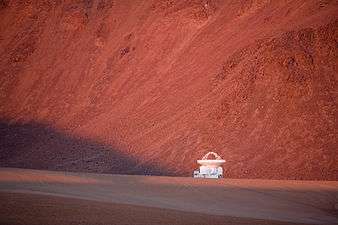Llano de Chajnantor Observatory
 | |
| Location | Antofagasta Region, Chile |
|---|---|
| Coordinates | 23°01′22″S 67°45′18″W / 23.0228°S 67.755°WCoordinates: 23°01′22″S 67°45′18″W / 23.0228°S 67.755°W |
| Altitude | 4,800 m (15,700 ft) |
| Telescopes | Atacama Large Millimeter Array, Atacama Pathfinder Experiment, Atacama Submillimeter Telescope Experiment, NANTEN2 Observatory, Atacama Cosmology Telescope, QUIET, POLARBEAR, University of Tokyo Atacama Observatory |
Llano de Chajnantor Observatory is the name for a group of astronomical observatories located at an altitude of over 4,800 m (15,700 ft) in the Atacama Desert of northern Chile. The site is in the Antofagasta Region approximately 50 kilometres (31 mi) east of the town of San Pedro de Atacama. The exceptionally arid climate of the area is inhospitable to humans, but creates an excellent location for millimeter, submillimeter, and mid-infrared astronomy.[1] This is because water vapour absorbs and attenuates submillimetre radiation. Llano de Chajnantor is home to the largest and most expensive astronomical telescope project in the world, the Atacama Large Millimeter Array (ALMA). Llano de Chajnantor and the surrounding area has been designated as the Chajnantor Science Reserve (Spanish: Reserva Científica de Chajnantor) by the government of Chile.[2]
Site description
The Llano de Chajnantor is located on the western side of the Puna de Atacama, which is another name for the southern part of the Altiplano. The main ridge of the Andes is over 200 kilometres (120 mi) to the east, well into Argentina. The Salar de Atacama basin borders the Puna de Atacama to the west, which in turn is bordered by the Cordillera Domeyko. The western side of the Puna de Atacama is dotted with the volcanoes of the Central Volcanic Zone of the Andean Volcanic Belt. The Llano de Chajnantor site itself is bounded by volcanic peaks of the Purico Complex, which have been active in the Holocene but have not erupted in historic times.[3] Cerro Chajnantor is to the north, Cerro El Chascón to the east, and smaller peaks to the south and west. The Pampa la Bola lies to the northeast, north of Cerro El Chascón and east of Cerro Chajnantor. Llano de Chajnantor has an average elevation of 5,000 m (16,000 ft), while Pampa la Bola averages 4,800 m (15,700 ft). The thin atmosphere makes work difficult for humans, so much of the activity for ALMA will be conducted at a base camp in the Salar de Atacama basin at approximately 2,900 m (9,500 ft) in elevation.

Rainfall at the ALMA site averages 100 mm (3.9 in) annually.[4] The dry climate of Llano de Chajnantor is due to three factors: the rain shadows created by the Andes and the Chilean Coastal Range, the inversion created by the Humboldt Current off the coast of Chile, and dry air descending between the Hadley cell and the Ferrel cell, which forms the South Pacific High.[5] While the site is generally viewed as being in the Atacama Desert, in terms of ecoregions it is in the Central Andean dry puna. Llano de Chajnantor is at the same latitude as deserts in southern Africa and central Australia.
Telescopes
Telescopes on Llano de Chajnantor


- The Atacama Large Millimeter Array (ALMA) is a large submillimetre radio telescope interferometer at Llano de Chajnantor, consisting of 54 12 m (39 ft) and 12 7 m (23 ft) parabolic antennas. Due to the high projected total cost of over $1.3 billion, ALMA has been developed and is run by a consortium led by the National Radio Astronomy Observatory and the European Southern Observatory, which are consortiums themselves.[6] It has been in full operation since October 2013.
- The Atacama Pathfinder Experiment (APEX) is a 12 m (39 ft) submillimetre radio telescope installed in 2003 and inaugurated in 2005. It's design is based on the North American ALMA prototype antenna modified for single dish use. It is operated by a consortium led by the Max Planck Institute for Radio Astronomy.[7]
Telescopes on Pampa la Bola
- The Atacama Submillimeter Telescope Experiment (ASTE) is a 10 m (33 ft) submillimetre radio telescope built by Mitsubishi Electric. It was an early prototype for the antennas of ALMA, and is operated by a consortium led by the National Astronomical Observatory of Japan. It was first built in Japan in 2000, and then was reassembled in Chile in 2002. It began regular observations in 2004.[8]
- The NANTEN2 Observatory (NANTEN2) is 4.0 m (13.1 ft) millimeter-wavelength radio telescope operated by a consortium led by the University of Cologne. In 2004 it was moved from Las Campanas Observatory, where it had operated since 1995.[9]
Telescopes on adjacent peaks
- The Atacama Cosmology Telescope (ACT) is 6.0 m (19.7 ft) Gregorian telescope designed to survey the sky at microwave wavelengths. It was installed on the western side of Cerro Toco in 2007 and is operated by a consortium led by Princeton University.[11]
- The University of Tokyo Atacama Observatory (TAO) is a planned 6.5 m (21 ft) optical and infrared telescope on Cerro Chajnantor, which is immediately north of Llano de Chajnantor. A test facility, the miniTAO, with a 1.0 m (3.3 ft) telescope was completed in 2009. It is currently the highest permanent astronomical observatory in the world.[12]
- The Cerro Chajnantor Atacama Telescope (CCAT) is a planned 25 m (82 ft) submillimetre radio telescope which will be located on Cerro Chajnantor near the TAO. Originally called the Cornell Caltech Atacama Telescope earlier in the development process, it is now referred to on the project's website by the CCAT acronym. Completion is expected in 2020.[13]
- The Huan Tran Telescope (HTT) is part of a project to measure the polarization of the cosmic microwave background radiation.[14] It is a 3.5 m (11 ft) Gregorian telescope. Attached to the telescope is the POLARBEAR experiment, which is an array of bolometers cooled to less than 1 K (−458 °F). HTT was first installed for testing at the CARMA site in 2010. It was moved to a location on Cerro Toco near the ACT in 2011 and saw first light in January 2012.[15] It was developed by a consortium led by the University of California, Berkeley.
Former telescopes
- The QU Imaging Experiment Telescope (QUIET) was a three-element radio telescope array designed to measure the polarization of the cosmic microwave background radiation. The telescopes were custom-designed of an unusual Mizuguchi-Dragone design fitted with highly sensitive bolometers. The project, led by the University of Chicago, was installed in 2009 in the facility that previously housed the CBI array until 2011.[16]
- The Cosmic Background Imager (CBI) was a radio telescope interferometer designed to measure the intensity and polarization of the cosmic microwave background radiation. It operated with thirteen 0.9 m (3.0 ft) antennas between 1999 and 2006, and until 2008 with 1.4 m (4.6 ft) antennas. The CBI facility is now used by the QUIET experiment.[17]
- The Millimeter-wave Interferometer (MINT) was a heterogenous four-element array that operated on the slopes of Cerro Toco in late 2001. The prototype instrument contained two 0.3 m (12 in) and two 0.45 m (18 in) Cassegrain reflectors. It was designed to measure the cosmic microwave background radiation.[18]
- The Mobile Anisotropy Telescope (MAT, or MAT/TOCO) was a 0.8 m (2.6 ft) telescope that was designed to measure the anisotropy of the cosmic microwave background radiation. It originally was the gondola of the QMAP balloon-borne experiment. It operated on the slopes of Cerro Toco in late 1997 and again in late 1998.[19]
See also
- List of highest astronomical observatories
- Purico Complex
- Paranal Observatory
- La Silla Observatory
- Cerro Tololo Inter-American Observatory
- Very Large Telescope
- European Extremely Large Telescope
References
- ↑ Bustos, R.; Rubio, M.; Otárola, A.; Nagar, N. (2014). "Parque Astronómico de Atacama: An Ideal Site for Millimeter, Submillimeter, and Mid-Infrared Astronomy". Publications of the Astronomical Society of the Pacific. 126 (946): 1126. arXiv:1410.2451
 . Bibcode:2014PASP..126.1126B. doi:10.1086/679330.
. Bibcode:2014PASP..126.1126B. doi:10.1086/679330. - ↑ "Topographical Map of CONICYT Science Preserve" (PDF). National Radio Astronomy Observatory. Retrieved 2012-01-26.
- ↑ "Purrico Complex". Global Volcanism Program. Smithsonian Institution. Retrieved 2012-01-26.
- ↑ "The best observing sites on Earth". Atacama Large Millimeter/submillimeter Array. Retrieved 2012-01-26.
- ↑ Garreaud, René D.; Molina, Alejandra; Farias, Marcelo (2010). "Andean uplift, ocean cooling and Atacama hyperaridity: A climate modeling perspective". Earth and Planetary Science Letters. 292: 39. Bibcode:2010E&PSL.292...39G. doi:10.1016/j.epsl.2010.01.017.
- ↑ Wootten, A.; Thompson, A.R. (2009). "The Atacama Large Millimeter/Submillimeter Array". Proceedings of the IEEE. 97 (8): 1463. arXiv:0904.3739
 . Bibcode:2009IEEEP..97.1463W. doi:10.1109/JPROC.2009.2020572.
. Bibcode:2009IEEEP..97.1463W. doi:10.1109/JPROC.2009.2020572. - ↑ Güsten, R.; Nyman, L. Å.; Schilke, P.; Menten, K.; Cesarsky, C.; Booth, R. (2006). "The Atacama Pathfinder EXperiment (APEX) – a new submillimeter facility for southern skies –". Astronomy and Astrophysics. 454 (2): L13. Bibcode:2006A&A...454L..13G. doi:10.1051/0004-6361:20065420.
- ↑ Kohno, K. (2005). "The Atacama Submillimeter Telescope Experiment". The Cool Universe: Observing Cosmic Dawn. 344: 242. Bibcode:2005ASPC..344..242K.
- ↑ Kawamura, A.; Mizuno, N.; Yonekura, Y.; Onishi, T.; Mizuno, A.; Fukui, Y. (2005). "NANTEN2: A Submillimeter Telescope for Large Scale Surveys at Atacama". Astrochemistry: Recent Successes and Current Challenges. 235: 275P. Bibcode:2005IAUS..235P.275K.
- ↑ "APEX Under the Moon". ESO Picture of the Week. Retrieved 12 February 2013.
- ↑ Fowler, J. W.; Niemack, M. D.; Dicker, S. R.; Aboobaker, A. M.; Ade, P. A. R.; Battistelli, E. S.; Devlin, M. J.; Fisher, R. P.; et al. (2007). "Optical design of the Atacama Cosmology Telescope and the Millimeter Bolometric Array Camera". Applied Optics. 46 (17): 3444–54. arXiv:astro-ph/0701020
 . Bibcode:2007ApOpt..46.3444F. doi:10.1364/AO.46.003444. PMID 17514303.
. Bibcode:2007ApOpt..46.3444F. doi:10.1364/AO.46.003444. PMID 17514303. - ↑ Minezaki, Takeo; Kato, Daisuke; Sako, Shigeyuki; Konishi, Masahiro; Koshida, Shintaro; Mitani, Natsuko; Aoki, Tsutomu; Doi, Mamoru; Handa, Toshihiro (2010). Stepp, Larry M; Gilmozzi, Roberto; Hall, Helen J, eds. "The University of Tokyo Atacama 1.0-m Telescope". Proceedings of SPIE. 7733: 773356. doi:10.1117/12.856694.
|chapter=ignored (help) - ↑ Radford, S. J. E.; Giovanelli, R.; Sebring, T. A.; Zmuidzinas, J. (2009). "Ccat". Submillimeter Astrophysics and Technology: a Symposium Honoring Thomas G. Phillips ASP Conference Series. 417: 113. Bibcode:2009ASPC..417..113R.
- ↑ Keating, B.; Moyerman, S.; Boettger, D.; Edwards, J.; Fuller, G.; Matsuda, F.; Miller, N.; Paar, H.; Rebeiz, G.; et al. (2011). "Ultra High Energy Cosmology with POLARBEAR". 1110: 2101. arXiv:1110.2101
 . Bibcode:2011arXiv1110.2101K.
. Bibcode:2011arXiv1110.2101K. - ↑ "First Light in Chile!". University of California Berkeley Department of Physics. Retrieved 2012-03-05.
- ↑ Bischoff, C.; Brizius, A.; Buder, I.; Chinone, Y.; Cleary, K.; Dumoulin, R. N.; Kusaka, A.; Monsalve, R.; et al. (2011). "FIRST SEASON QUIET OBSERVATIONS: MEASUREMENTS OF COSMIC MICROWAVE BACKGROUND POLARIZATION POWER SPECTRA AT 43 GHz IN THE MULTIPOLE RANGE 25 ⩽ $\ell$ ⩽ 475". The Astrophysical Journal. 741 (2): 111. arXiv:1012.3191
 . Bibcode:2011ApJ...741..111Q. doi:10.1088/0004-637X/741/2/111.
. Bibcode:2011ApJ...741..111Q. doi:10.1088/0004-637X/741/2/111. - ↑ Taylor, Angela C.; Jones, Michael E.; Allison, James R.; Angelakis, Emmanouil; Bond, J. Richard; Bronfman, Leonardo; Bustos, Ricardo; Davis, Richard J.; et al. (2011). "The Cosmic Background Imager 2". Monthly Notices of the Royal Astronomical Society. 418 (4): 2720. arXiv:1108.3950
 . Bibcode:2011MNRAS.418.2720T. doi:10.1111/j.1365-2966.2011.19661.x.
. Bibcode:2011MNRAS.418.2720T. doi:10.1111/j.1365-2966.2011.19661.x. - ↑ Fowler, J. W.; Doriese, W. B.; Marriage, T. A.; Tran, H. T.; Aboobaker, A. M.; Dumont, C.; Halpern, M.; Kermish, Z. D.; Loh, Y.‐S.; Page, L. A.; Staggs, S. T.; Wesley, D. H. (2005). "Cosmic Microwave Background Observations with a Compact Heterogeneous 150 GHz Interferometer in Chile". The Astrophysical Journal Supplement Series. 156: 1. arXiv:astro-ph/0403137
 . Bibcode:2005ApJS..156....1F. doi:10.1086/426393.
. Bibcode:2005ApJS..156....1F. doi:10.1086/426393. - ↑ Miller, A.; Beach, J.; Bradley, S.; Caldwell, R.; Chapman, H.; Devlin, M. J.; Dorwart, W. B.; Herbig, T.; et al. (2002). "The QMAP and MAT/TOCO Experiments for Measuring Anisotropy in the Cosmic Microwave Background". The Astrophysical Journal Supplement Series. 140 (2): 115. arXiv:astro-ph/0108030
 . Bibcode:2002ApJS..140..115M. doi:10.1086/339686.
. Bibcode:2002ApJS..140..115M. doi:10.1086/339686.
External links
- Atacama Large Millimeter/sub-millimeter Array public site homepage
- Description of a trip to Llano de Chajnantor Observatory on BBC News

